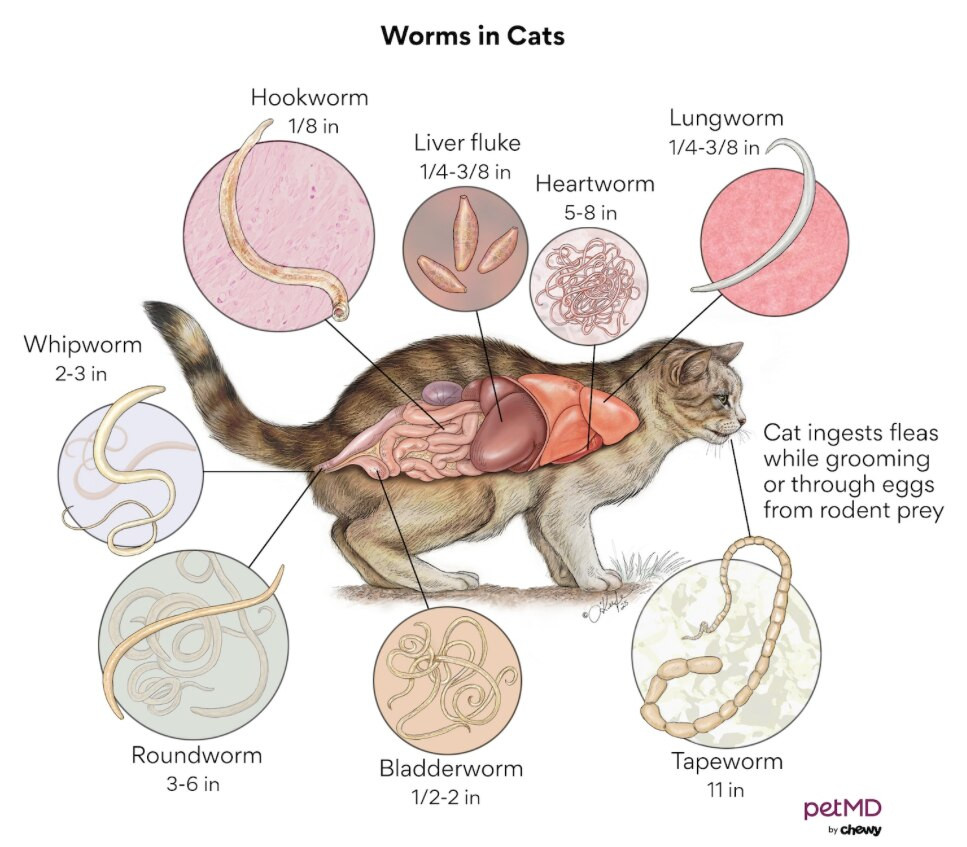Discovering tapeworms in your cat can be unsettling. These common parasites, while often not seriously dangerous, are certainly unpleasant and require prompt attention. If your feline friend roams outdoors, encountering tapeworms is a possibility, reinforcing the benefits of keeping cats indoors. This guide will walk you through everything you need to know about identifying, treating, and preventing tapeworms in cats, ensuring your pet stays healthy and parasite-free.
 Diagram of tapeworms in a cat's intestine showing tapeworm segments. Learn how to get rid of tapeworms in cats.
Diagram of tapeworms in a cat's intestine showing tapeworm segments. Learn how to get rid of tapeworms in cats.
Recognizing Tapeworms: What to Look For
The most obvious sign of tapeworms in cats is the presence of proglottids, or tapeworm segments. These segments are reproductive parts of the tapeworm and are shed in your cat’s feces. Keep an eye out for these tell-tale signs:
- Rice-like segments: Fresh proglottids often resemble grains of white rice. You might spot them wiggling near your cat’s anus, in their stool, or on bedding.
- Dried segments: As they dry, these segments become yellowish and harder, sometimes clinging to the fur around your cat’s rear.
- Subtle Symptoms: Beyond visible segments, tapeworm infections can sometimes cause:
- Anal irritation: Your cat might scoot or lick excessively at their rear end due to discomfort.
- Occasional vomiting: Though less common, vomiting can occur.
- Rarely, more severe signs: In unusual cases, a heavy tapeworm infestation could lead to intestinal blockage, loss of appetite, weight loss, and lethargy. However, most cats with tapeworms show very few outward symptoms apart from the proglottids.
How Cats Get Tapeworms: Understanding the Causes
To effectively get rid of tapeworms, it’s crucial to understand how cats become infected. There are a few main types of tapeworms that affect cats, each with a different transmission method:
- Dipylidium caninum: The most common type, transmitted through fleas. Cats ingest fleas, often during grooming, that are carrying tapeworm larvae.
- Taenia taeniaeformis (Hydatigera taeniaeformis): Acquired by hunting and eating infected rodents. This is why outdoor cats who are keen hunters are more susceptible.
- Echinococcus multilocularis: Less common but potentially more serious, also contracted through eating infected rodents, particularly mice and squirrels.
Diagnosing Tapeworms: Veterinary Confirmation
While seeing proglottids is a strong indicator of tapeworms, a veterinarian can confirm the diagnosis and recommend the best course of action to get rid of them.
- Visual Examination: Veterinarians often diagnose tapeworms based on the presence of proglottids during a physical exam or from your description of what you’ve observed at home.
- Fecal Flotation Test: While less reliable for tapeworms compared to other intestinal worms, a fecal test might reveal tapeworm eggs. However, proglottids are more commonly used for diagnosis.
- Specialized Fecal Testing: For suspected Echinococcus infections, your vet might send a fecal sample to a laboratory for more specific testing due to the zoonotic potential of this parasite.
Getting Rid of Tapeworms: Effective Treatment Options
Treating tapeworms in cats is generally straightforward and highly effective. Veterinarians typically prescribe medication to eliminate these parasites.
- Praziquantel: This is the most commonly prescribed medication for tapeworms in cats. It works by causing the tapeworm to lose its ability to resist digestion by the cat’s intestines. It is available in various forms:
- Prescription Injectable or Oral Medications: Your veterinarian can administer praziquantel via injection or prescribe oral tablets.
- Over-the-Counter Options: Praziquantel is also available in some over-the-counter dewormers specifically formulated for tapeworms in cats. However, consulting your vet is always recommended before administering any medication, even OTC options.
- Epsiprantel: Another prescription medication effective against tapeworms, available as oral tablets.
- Fenbendazole and Nitroscanate: These medications might be used in certain situations, as determined by your veterinarian.
Important Note: Always consult with your veterinarian for the correct diagnosis and treatment plan. While over-the-counter options exist, professional guidance ensures the most effective and safe approach for your cat.
Recovery and Post-Treatment Care
Most cats recover quickly and completely after tapeworm treatment.
- Tapeworm Breakdown: The medication causes the tapeworms to be digested within the cat’s intestines. You might occasionally see expelled tapeworm segments in your cat’s feces after treatment, especially in heavy infestations.
- Minimal Side Effects: Side effects from tapeworm medications are rare. If your cat seems unwell after treatment, contact your veterinarian for advice.
- Re-infection is Possible: Tapeworm medications only eliminate existing tapeworms. They do not prevent future infections. Cats can become re-infected immediately if exposed to fleas or infected prey again. Prevention is key to long-term tapeworm control.
Preventing Tapeworms: Long-Term Strategies
Preventing tapeworms is crucial for your cat’s ongoing health, especially since re-infection is common. Focus on these two key prevention strategies:
- Effective Flea Control: Since Dipylidium caninum tapeworms are transmitted by fleas, consistent flea prevention is paramount.
- Year-Round Flea Preventatives: Use veterinarian-recommended flea control products regularly, even for indoor cats, as fleas can be brought into the home.
- Treat All Pets: If you have multiple pets, ensure all are on flea prevention to break the flea life cycle.
- Limit Hunting: To prevent Taenia and Echinococcus tapeworms, reduce your cat’s hunting behavior.
- Keep Cats Indoors: The most effective way to prevent hunting is to keep cats indoors. This also protects them from numerous other hazards.
- Supervise Outdoor Time: If your cat goes outside, supervise their time and discourage hunting.
Regular Deworming: For cats at high risk of re-infection (e.g., outdoor hunters), your veterinarian might recommend regular deworming with praziquantel or other suitable medications as a preventive measure.
FAQs about Tapeworms in Cats
Are cat tapeworms contagious to humans?
Yes, some cat tapeworms can be transmitted to humans, though it is not common.
- Dipylidium caninum: Humans, especially children, can get this type of tapeworm by accidentally ingesting infected fleas. Good hygiene practices, like handwashing after petting your cat, are essential.
- Taenia taeniaeformis: Human infection is rare and not typically associated with cats; usually linked to eating undercooked pork.
- Echinococcus multilocularis: This tapeworm is a significant zoonotic concern. Humans can contract echinococcosis, a serious disease, by ingesting Echinococcus eggs. While less common in cats, it’s a reason to be diligent about prevention and hygiene, especially if living in or traveling to areas where this parasite is more prevalent.
How do indoor cats get tapeworms?
Indoor cats can still get tapeworms, primarily through fleas.
- Fleas Indoors: Fleas can enter homes on other pets, on people’s clothing, or through rodents. Once inside, they can easily infest an indoor cat, especially if preventative measures are not in place.
- Indoor Hunting: Although less common, indoor cats might hunt mice or other rodents that find their way inside, potentially leading to Taenia or Echinococcus infections.
How can I treat tapeworms in cats at home?
While some over-the-counter tapeworm medications are available, consulting your veterinarian is always recommended for the best approach.
- Veterinary Guidance is Key: It’s crucial to confirm that your cat has tapeworms and to rule out other potential health issues. Your vet can recommend the most appropriate medication and dosage.
- Over-the-Counter Medications: If you choose an OTC option, select a product specifically labeled for tapeworm treatment in cats and containing praziquantel. Follow the product instructions carefully. Even with OTC treatments, if you are unsure, consult your vet.
By understanding how to recognize, treat, and prevent tapeworms, you can take proactive steps to protect your feline companion and ensure they live a healthy, comfortable, and parasite-free life. Regular veterinary check-ups and preventative measures are your best allies in keeping tapeworms at bay.
WRITTEN BASED ON INFORMATION FROM:
Jennifer Coates, DVM, Veterinarian

